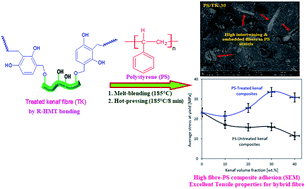Kenaf fibre treatment and its impact on the static, dynamic, hydrophobicity and barrier properties of sustainable polystyrene biocomposites
Abstract
Natural fibre-polymer adhesion can be improved by treating the fibre surface or polymer. In this study, resorcinol-hexamethylenetetramine mixture (R-HMT) is used as a chemical treatment for kenaf fibre waste to extend the interfacial adhesion between the fibre-polystyrene matrices. The effect of the untreated and treated kenaf fibre (designated as UK and TK fibre) on the thermal (DSC), viscoelastic, mechanical, hydrophobicity, and barrier properties of polystyrene (PS) was studied. Four different percentages of each type of fibre (10, 20, 30, and 40 wt%) were used. The chemical structure of the TK fibre was confirmed by Fourier-transform infrared spectroscopy (FT-IR) analysis. The compatibility of the fibre-polymer was investigated by scanning electron microscopy (SEM). The results showed that the use of the treated fibre at 30 wt%, enhanced the tensile strength by 148% and 212% compared to neat PS and PS/UK-30, respectively, indicating a good fibre bond adhesion. The DMA data demonstrated that the storage modulus increased significantly, especially for the PS/TK-30 composite. Meanwhile, the glass transition temperature (Tg) shifted to a lower temperature for both types of fibre. Also, the hydrophobicity of the PS composites, which was determined by thickness swelling measurements, was improved when the TK fibre was inserted. Furthermore, water vapor and oxygen transmission rates were determined. A good correlation between most of the properties for the PS composite-based treated fibre was observed, which revealed the possibility of using these materials for sustainable automotive components and gas sensitive packaging applications.



 Please wait while we load your content...
Please wait while we load your content...